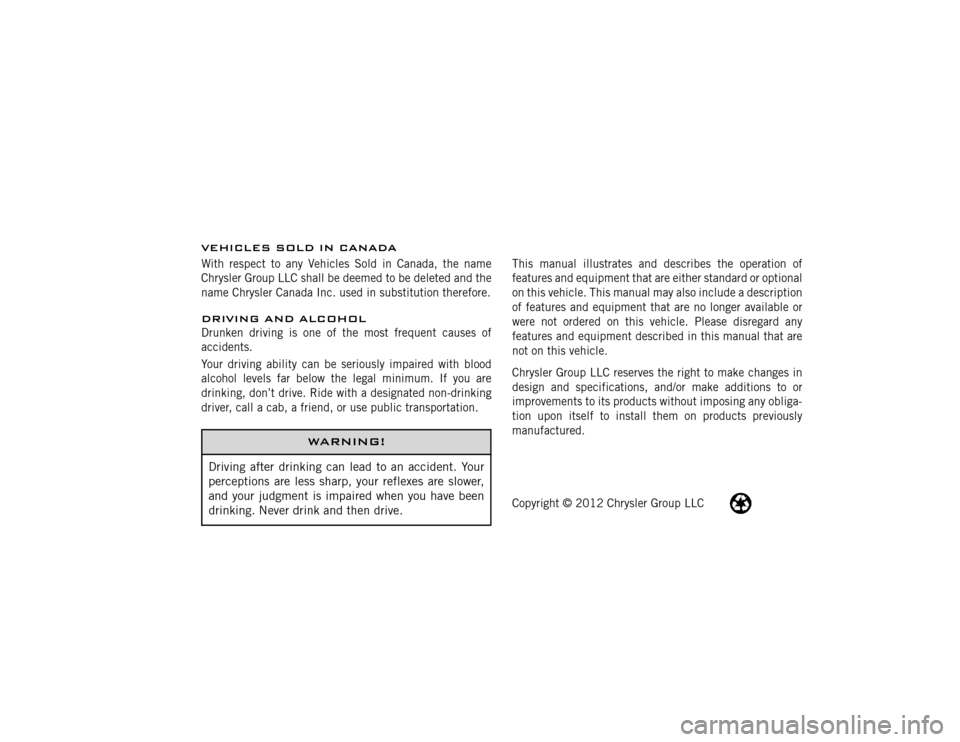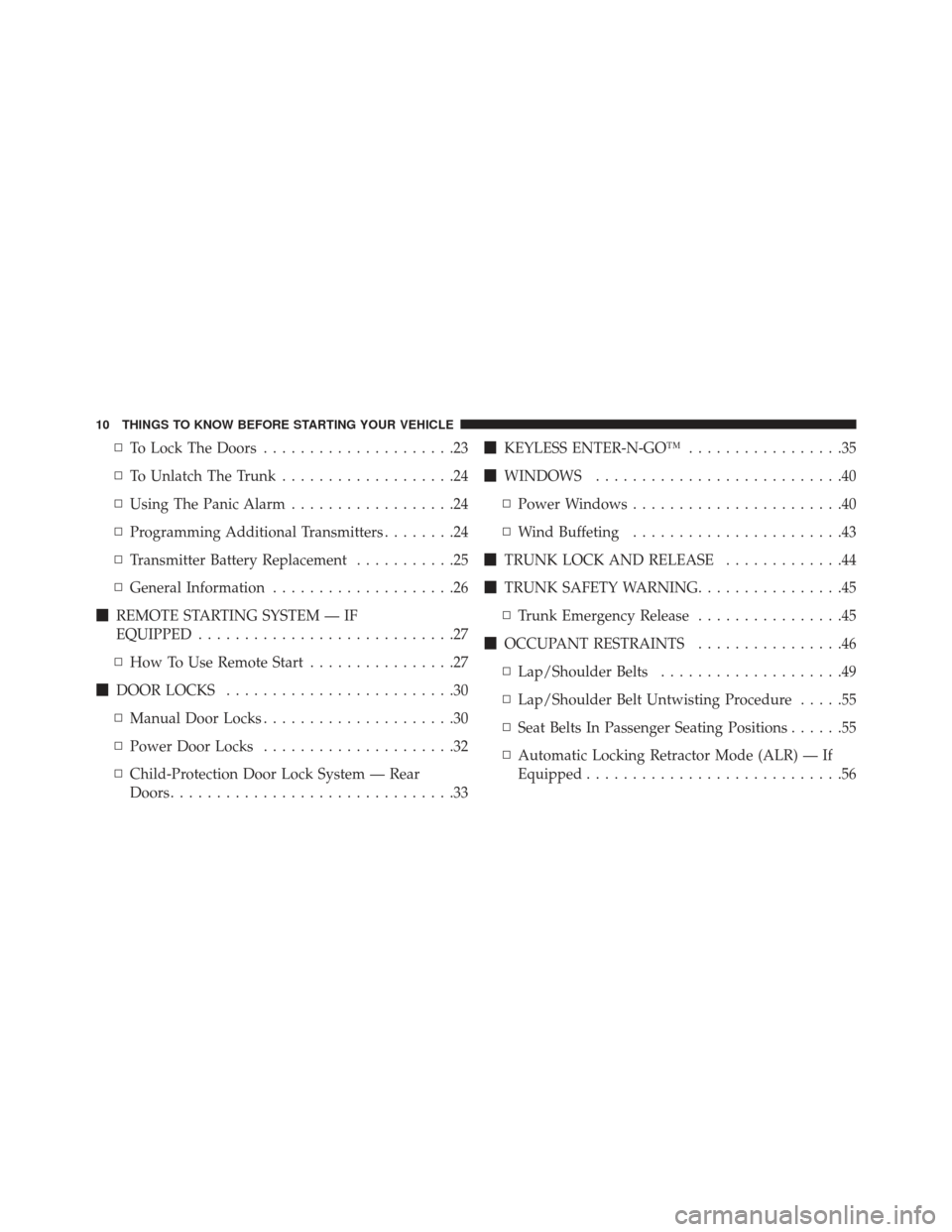Page 2 of 631

VEHICLES SOLD IN CANADAWith respect to any Vehicles Sold in Canada, the name
Chrysler Group LLC shall be deemed to be deleted and the
name Chrysler Canada Inc. used in substitution therefore.DRIVING AND ALCOHOLDrunken driving is one of the most frequent causes of
accidents.
Your driving ability can be seriously impaired with blood
alcohol levels far below the legal minimum. If you are
drinking, don’t drive. Ride with a designated non-drinking
driver, call a cab, a friend, or use public transportation.
WARNING!
Driving after drinking can lead to an accident. Your
perceptions are less sharp, your reflexes are slower,
and your judgment is impaired when you have been
drinking. Never drink and then drive.
This manual illustrates and describes the operation of
features and equipment that are either standard or optional
on this vehicle. This manual may also include a description
of features and equipment that are no longer available or
were not ordered on this vehicle. Please disregard any
features and equipment described in this manual that are
not on this vehicle.
Chrysler Group LLC reserves the right to make changes in
design and specifications, and/or make additions to or
improvements to its products without imposing any obliga-
tion upon itself to install them on products previously
manufactured.
Copyright © 2012 Chrysler Group LLC
Page 5 of 631
INTRODUCTION
CONTENTS
�INTRODUCTION ........................4
� HOW TO USE THIS MANUAL ..............4
� WARNINGS AND CAUTIONS ..............6�
VEHICLE IDENTIFICATION NUMBER ........6
� VEHICLE MODIFICATIONS/ALTERATIONS ....7
1
Page 8 of 631
WARNINGS AND CAUTIONS
This Owners Manual containsWARNINGSagainst oper-
ating procedures that could result in a collision or bodily
injury. It also contains CAUTIONSagainst procedures that
could result in damage to your vehicle. If you do not read
this entire Owners Manual, you may miss important
information. Observe all Warnings and Cautions.
VEHICLE IDENTIFICATION NUMBER
The Vehicle Identification Number (VIN) is on the left
front corner of the instrument panel. The VIN is visible
from outside of the vehicle through the windshield. This
number also appears on the Automobile Information
Disclosure Label affixed to a window on your vehicle, the
vehicle registration, and the title.
The vehicle identification number (VIN) is also located on
the right front strut tower inside the engine compartment.
VIN Location
6 INTRODUCTION
Page 9 of 631
NOTE:It is illegal to remove or alter the VIN.
VEHICLE MODIFICATIONS/ALTERATIONS
WARNING!
Any modifications or alterations to this vehicle could
seriously affect its roadworthiness and safety and may
lead to a collision resulting in serious injury or death.
VIN Location
1
INTRODUCTION 7
Page 12 of 631

▫To Lock The Doors .....................23
▫ To Unlatch The Trunk ...................24
▫ Using The Panic Alarm ..................24
▫ Programming Additional Transmitters ........24
▫ Transmitter Battery Replacement ...........25
▫ General Information ....................26
� REMOTE STARTING SYSTEM — IF
EQUIPPED ............................27
▫ How To Use Remote Start ................27
� DOOR LOCKS .........................30
▫ Manual Door Locks .....................30
▫ Power Door Locks .....................32
▫ Child-Protection Door Lock System — Rear
Doors ...............................33 �
KEYLESS ENTER-N-GO™ .................35
� WINDOWS ...........................40
▫ Power Windows .......................40
▫ Wind Buffeting .......................43
� TRUNK LOCK AND RELEASE .............44
� TRUNK SAFETY WARNING ................45
▫ Trunk Emergency Release ................45
� OCCUPANT RESTRAINTS ................46
▫ Lap/Shoulder Belts ....................49
▫ Lap/Shoulder Belt Untwisting Procedure .....55
▫ Seat Belts In Passenger Seating Positions ......55
▫ Automatic Locking Retractor Mode (ALR) — If
Equipped ............................56
10 THINGS TO KNOW BEFORE STARTING YOUR VEHICLE
Page 17 of 631

Ignition Or Accessory On Message
Opening the driver’s door when the ignition is in ACC or
ON (engine not running), a chime will sound to remind
you to cycle the ignition to OFF. In addition to the chime,
the ignition or accessory on message will display in the
cluster.
NOTE:With the Uconnect® system, the power window
switches, radio, power sunroof (if equipped), and power
outlets will remain active for up to 10 minutes after the
ignition is cycled to the OFF position. Opening either
front door will cancel this feature. The time for this
feature is programmable. Refer to “Uconnect® Settings”
in “Understanding Your Instrument Panel” for further
information.
WARNING!
• When leaving the vehicle, always remove the Key
Fob from the vehicle and lock your vehicle.
• Never leave children alone in a vehicle, or with
access to an unlocked vehicle.
• Allowing children to be in a vehicle unattended is
dangerous for a number of reasons. A child or
others could be seriously or fatally injured. Chil-
dren should be warned not to touch the parking
brake, brake pedal or the shift lever.
• Do not leave the Key Fob in or near the vehicle, or
in a location accessible to children, and do not
leave a vehicle equipped with Keyless Enter-N-
Go™ in the ACC or ON/RUN mode. A child could
operate power windows, other controls, or move
the vehicle.
(Continued)
2
THINGS TO KNOW BEFORE STARTING YOUR VEHICLE 15
Page 18 of 631

WARNING!(Continued)
•Do not leave children or animals inside parked
vehicles in hot weather. Interior heat build-up may
cause serious injury or death.
CAUTION!
An unlocked car is an invitation to thieves. Always
remove the Key Fob from vehicle, cycle the ignition
OFF and lock all doors when leaving the vehicle
unattended.
SENTRY KEY®
The Sentry Key® Immobilizer system prevents unauthor-
ized vehicle operation by disabling the engine. The
system does not need to be armed or activated. Operation
is automatic, regardless of whether the vehicle is locked
or unlocked. The system uses a Key Fob with Remote Keyless Entry
(RKE) transmitter, a Keyless Ignition Node (KIN) and a
RF receiver to prevent unauthorized vehicle operation.
Therefore, only Key Fobs that are programmed to the
vehicle can be used to start and operate the vehicle.
After cycling the ignition to the ON/RUN position, the
Vehicle Security Light will turn on for three seconds for a
bulb check. If the light remains on after the bulb check, it
indicates that there is a problem with the electronics. In
addition, if the light begins to flash after the bulb check,
it indicates that someone used an invalid Key Fob to start
the engine. Either of these conditions will result in the
engine being shut off after two seconds.
If the Vehicle Security Light turns on during normal
vehicle operation (vehicle running for longer than 10 sec-
onds), it indicates that there is a fault in the electronics.
Should this occur, have the vehicle serviced as soon as
possible by an authorized dealer.
16 THINGS TO KNOW BEFORE STARTING YOUR VEHICLE
Page 30 of 631

•BRAKE switch inactive (brake pedal not pressed)
• Battery at an acceptable charge level
• RKE PANIC button not pressed
• System not disabled from previous remote start event
• Vehicle theft alarm not active
• Ignition in OFF position
WARNING!
•Do not start or run an engine in a closed garage or
confined area. Exhaust gas contains Carbon Mon-
oxide (CO) which is odorless and colorless. Carbon
Monoxide is poisonous and can cause serious in-
jury or death when inhaled.
(Continued)
WARNING! (Continued)
•Keep Remote Keyless Entry (RKE) transmitters
away from children. Operation of the Remote Start
System, windows, door locks or other controls
could cause serious injury or death.
Remote Start Abort Message On Electronic Vehicle
Information Center (EVIC) — If Equipped
The following messages will display in the EVIC if the
vehicle fails to remote start or exits remote start prematurely:
• Remote Start Aborted — Door Ajar
• Remote Start Aborted — Hood Ajar
• Remote Start Aborted — Trunk Ajar
• Remote Start Aborted — Fuel Low
• Remote Start Disabled — Start Vehicle To Reset
28 THINGS TO KNOW BEFORE STARTING YOUR VEHICLE